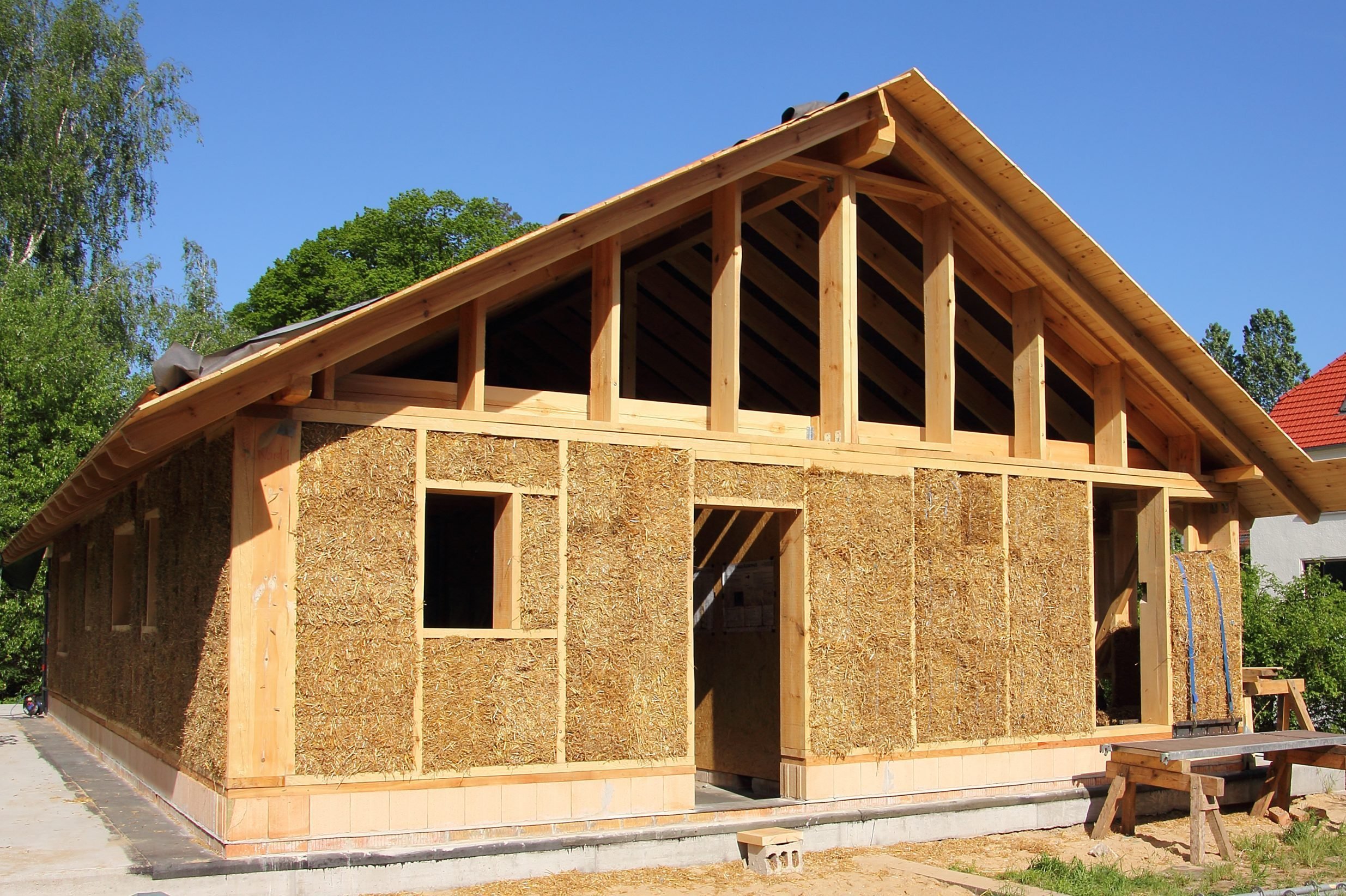Straw is a traditional building material, but today's building methods are relatively new. Discover how modern straw bale construction has evolved.

Pros and Cons of Straw Bale Construction

People have built houses from straw since the Paleolithic Era, but modern straw bale construction originated on the plains of Nebraska more than 100 years ago. Andrew Morrison of StrawBale.com says that was when automatic baling machines made heavy straw bale building blocks available to builders who were versed in cob (mud and straw) construction methods. Hay bale gardens are also a smart and economical option you should consider for growing vegetables.
Today, far from being a fringe building method, straw bale construction is code-approved. It has its own section in Appendix S of the International Residential Code (IRC), which has been adopted by every state except Wisconsin. It’s a method also used all over the world. If you’re wondering what it would be like to live in a straw bale house, a word that would definitely sum it up is cozy. Straw bales have up to three times the R-value of conventional home insulation, along with excellent soundproofing and fireproofing characteristics. Morrison is a longtime straw bale advocate who teaches construction methods on his website.
“The thick walls create a strong feeling of security and the gentle undulations within the natural materials create a deep sense of beauty,” Morrison says. “It’s not uncommon for people to literally walk up to walls and rub their hands on them. I’ve never seen anyone do that in a conventionally built, stick frame and drywall house!”
On This Page
Two Approaches to Straw Bale Construction
One version of a straw bale home is a “Nebraska-style” structure. Bales are piled on top of each other and support the roof, which can be made from any conventional roofing material. Another way: Build a structural frame to support the roof and use the bales to fill in the walls.
Morrison calls the second approach the infill method. He says it’s more common because it allows more flexibility and fewer design restraints. Although standard doors and windows can be framed into both types, it’s easier to include them in a post-and-beam structure.
Sometimes the “Nebraska” and infill methods are used on the same building. Inclusion of a basement is “always possible,” Morrison says, but it requires interior footings and stem walls to keep the bales above grade.
Building Considerations
No matter which construction method you use, the bales are typically laid flat rather than on edge for extra strength. They’re anchored together with wood, bamboo or rebar.
Any type of roof that can be supported by the walls and meets local engineering requirements is possible. But the extra load created by the heavy bales must be factored into the engineering design, particularly for multi-story buildings.
The bales must be covered inside and outside the building. While there are many possibilities, including conventional plywood sheathing, Morrison’s material of choice is natural hydraulic lime plaster. It’s durable, flexible and provides excellent weather protection. The latter is a must, given the vulnerability of rice, barley rye or oat straw to moisture.
Wheat straw, although plentiful, isn’t one of Morrison’s preferred materials. He says the stalks grown on factory farms are too short to make good bales.
Pros of Straw Bale Construction
Each year, some 200 million tons of straw are burned in the U.S., adding to the already dangerously high concentration of carbon dioxide in the atmosphere. Straw bale construction sequesters some of the carbon released by burning, thus helping reduce global warming.
Besides this ecological incentive, straw bale construction affords plenty of other benefits:
- Cheap raw materials for construction.
- Because straw bales are so tightly packed, they have three times the fire resistance of conventionally constructed walls. It seems counterintuitive, but straw bale is an excellent choice in areas prone to wildfires.
- The thick, dense walls are soundproof, making the home a refuge from the noisy world.
- Straw, if free of chemical fertilizers or insecticides, is non-toxic. No off-gassing and no hazardous materials.
- Construction can proceed rapidly, because the building materials are large and easy to assemble.
- Straw bales are flexible enough to resist collapse during an earthquake, and heavy and dense enough to stand up to high winds.
Cons of Straw Bale Construction
Straw bales shouldn’t get wet. They won’t be damaged by rain or inclement weather when properly coated with a protective material, but they can still be vulnerable to persistent high humidity.
For this reason, straw bale construction isn’t a good option in humid climates, such as the American Deep South. Moreover, bales must remain completely dry while construction proceeds.
Other problems:
- Straw bales are attractive to rodent and insect pests. The degree of infestation depends on moisture content, the percentage of grain residue and how long the straw was left out before being baled.
- “Nebraska-style” straw bale homes may not meet building code requirements everywhere.
- Lenders may regard straw bale homes as experimental or risky and refuse to finance them. Insurers may also decline coverage.
- Cracks in the exterior coating must be repaired promptly to prevent the bales from getting wet.
Finding Contractors
Like any building project, a straw bale house needs to conform to building codes. Best to consult with a contractor, even when planning this as a DIY project. Straw bale contractors aren’t common, but their numbers are growing as this building method becomes more popular.
In California, the California Straw Building Association (CASBA) is a reliable source of referrals. In Oregon, PSE Consulting Engineers, Inc. provides a link to structural engineers in and around the state versed in straw bale construction.
Whether working with a contractor or going it alone, prospective builders should navigating over to StrawBale.com for tutorials, tips and best practices for straw bale construction.




















